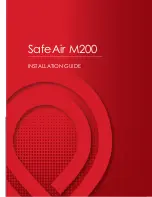
Strona
31
z
34
3.3.
Collection
of
the
petrol
injection
map
with
LPG
(LPG
map)
Having
collected
the
petrol
map,
switch
to
LPG
and
collect
the
LPG
map
in
the
same
way
the
petrol
map
was
collected.
The
LPG
map
should
be
collected
in
the
same
road
conditions
and
with
similar
loads
as
the
petrol
map.
The
LPG
map
is
drawn
with
green
points.
Having
collected
sufficient
number
of
green
points,
the
map
will
be
drawn
with
a
continuous
green
line.
If
the
controller
is
set
properly
(the
multiplier
characteristics
selected
properly),
the
petrol
and
the
LPG
maps
should
match.
If
the
maps
do
not
match,
the
multiplier
characteristic
should
be
corrected
at
the
points
where
the
maps
do
not
match
(the
lower
axis
of
co
‐
ordinates
for
injection
times).
If
the
LPG
map
is
collected
with
the
PC
connected
and
the
diagnostic
software
running,
it
is
possible
to
immediately
correct
the
multiplier
characteristics
when
the
collected
green
points
do
not
match
with
the
petrol
map.
It
is
even
strongly
recommended
to
use
the
PC
in
this
way
as
if
the
multiplier
characteristics
differ
strongly
from
the
required
ones,
the
controller
starts
to
switch
over
and
–
in
the
extreme
case
–
can
activate
the
“check”
signal
lamp.
When
correcting
the
multiplier
characteristics,
make
the
points
on
the
LPG
map
match
with
the
petrol
map.
Once
both
maps
match,
the
characteristics
are
properly
set.
3.4.
Checking
if
maps
match,
verification
of
deviations
Having
collected
the
petrol
and
LPG
maps
(both
maps
drawn
with
continuous
lines)
check
the
deviation
between
them.
In
the
Map
window
there
is
the
“Deflection”
button
located
on
the
right.
Press
it
to
see
the
deviation
graph
drawn
with
a
red
line.
If
the
deviation
fits
within
±
10%,
the
controller
is
programmed
properly;
otherwise,
the
multiplier
characteristics
should
be
corrected
at
points
where
maps
do
not
match.
3.5.
Controller
manual
setting
The
controller
may
also
be
set
up
manually,
which
–
provided
sufficient
experience
has
been
gained
–
may
prove
quicker
than
the
above
described
procedure.
Start
with
the
auto
‐
calibration
in
the
same
way
as
described
above
(this
is
necessary
to
ensure
the
controller
works
properly,
see
3.1).
If
the
auto
‐
calibration
finishes
properly
and
the
multiplier
values
are
correct
for
the
calibration
point,
switch
the
engine
to
petrol
and
take
it
for
a
ride.
The
multiplier
characteristics
need
to
be
set
in
the
following
way:
Drive
the
car
with
a
constant
load,
i.e.
the
petrol
injection
times
should
be
stable.
Adjust
the
engine
loads
so
that
the
injection
times
equal
e.g.
app.
5
[ms].
The
blue
marker
will
help
determine
the
injection
times
as
it
is
location
on
the
horizontal
axis
is
determined
by
the
injection
times.
Next,
switch
the
car
to
LPG
and
watch
the
blue
marker
for
variations
in
injection
times
when
compared
with
the
earlier
petrol
injection
times.
If
the
injection
times
decreased
(the
marker
moved
to
the
left)
it
means
that
for
the
selected
injection
times
the
multiplier
is
too
high
(the
mixture
is
too
rich).
In
this
case,
lower
the
multiplier
value
for
the
5
[ms]
injection
time
(in
our
case).
If
upon
switching
to
LPG
the
blue
marker
moves
to
the
right,
it
means
the
mixture
is
not
reach
enough
and
the
multiplier
needs
to
be
brought
up
for
given
injection
times.
The
procedure
described
above
should
be
performed
for
a
few
different
injection
times,
starting
at
the
calibration
point
all
the
way
until
heavy
load
injections.
You
can
check
the
multiplier
map
e.g.
every
2
[ms]
starting
at
the
calibration
point.
If
necessary,
add
a
point
at
the
multiplier
map
to
set
it
more
precisely.
Once
the
manual
setting
is
complete,
both
maps
–
petrol
and
LPG
–
should
match.




































